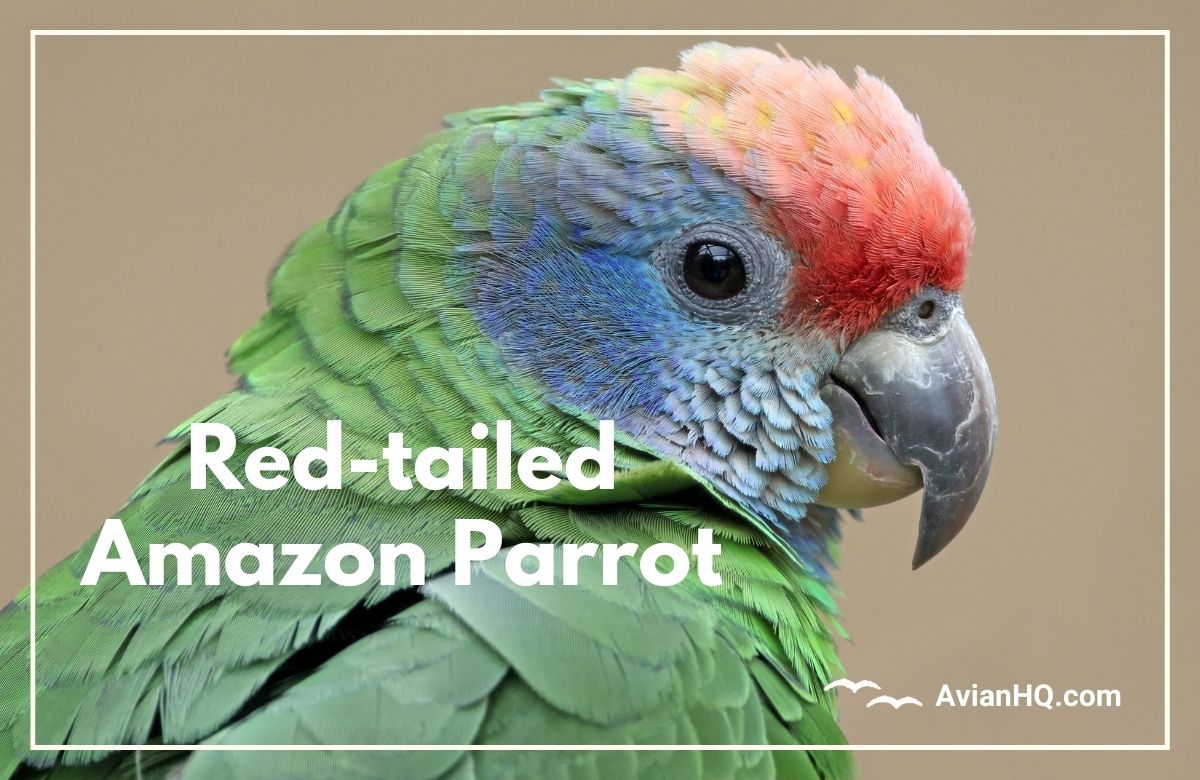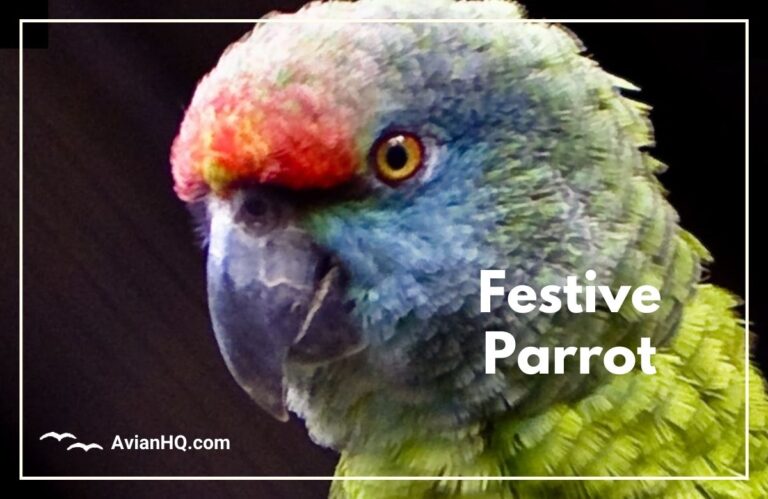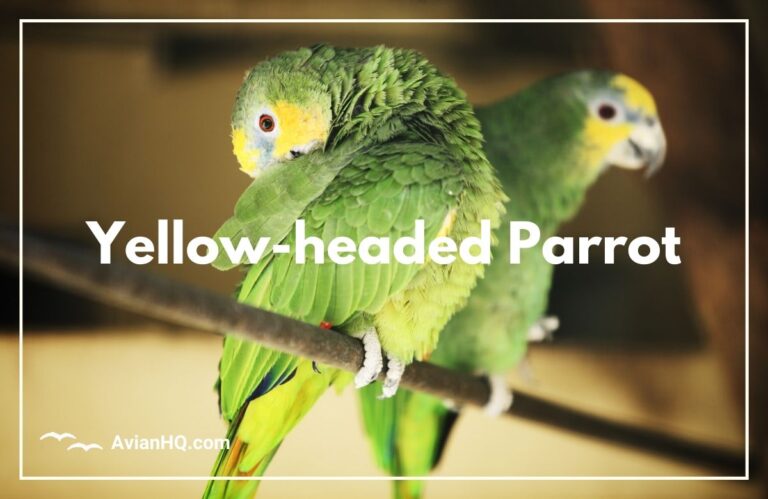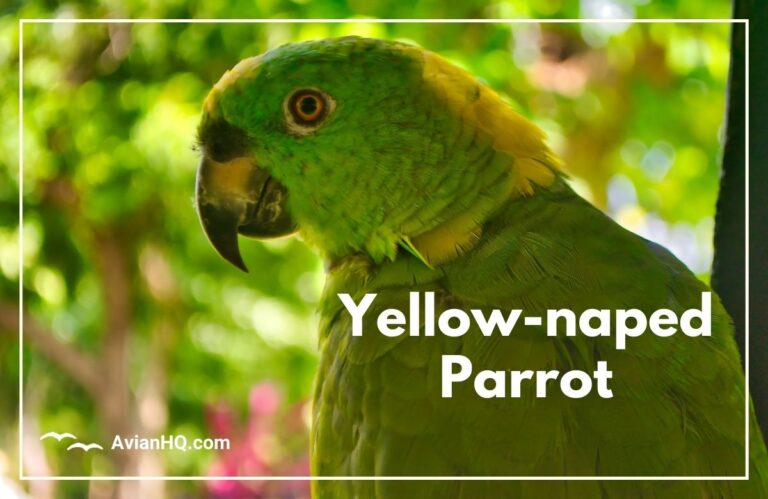Red-tailed Amazon Parrot (Amazona brasiliensis)
The brilliant red band across it’s tail makes the Red-tailed Parrot one of the most recognizable parrots of coastal Brazil. As you watch a flock pass by, flashes of red stand out against the green plumage. These vibrant tropical birds once faced a concerning decline, but focused conservation efforts have helped stabilize the species.
The Red-tailed Amazon Parrot is a medium-sized parrot measuring about 35 centimeters or 14 inches long. It’s green feathers have colorful accents of red, blue, and yellow. This endangered bird lives in a narrow habitat range in lowland Atlantic Forest ecosystems.
Deforestation severely reduced it’s forest home and the wild pet trade captured many individuals, causing the population to plummet. In the 1990s, it was feared only 2,000 Red-tailed Parrots remained. Now the population is estimated around 6,600 birds.
Ongoing challenges like trapping, logging, agriculture, and housing developments continue to threaten these parrots. But increased legal protections and habitat conservation offer hope for their future. As you learn more about these charismatic birds, you’ll better understand the threats they face and the efforts helping protect Brazil’s incredible biodiversity.
History and Taxonomy
The first known description of the Red-tailed Parrot comes from the English naturalist George Edwards in 1751. When he published his four-volume book A Natural History of Uncommon Birds, it included an illustration and details about the “Brasilian green parrot.” Edwards likely based his painting and description on a live Red-tailed Parrot seen in a bird shop in London.
A few years later in 1758, Swedish taxonomist Carl Linnaeus gave the parrot it’s scientific name Psittacus brasiliensis in the 10th edition of his influential book Systema Naturae. He also provided a brief description of the bird and cited Edwards’ earlier work.
Today, the Red-tailed Parrot resides in the genus Amazona along with nearly 30 other parrots. René Primevère Lesson introduced the genus Amazona in 1830. Scientists recognize no distinct subspecies of the Red-tailed Parrot.
Physical Appearance
The Red-tailed Parrot is a medium-sized bird, measuring around 35 centimeters or 14 inches long. They typically weigh approximately 425 grams or 15 ounces.
True to their common name, these parrots have a wide red band on their tails. However, since the red coloration occurs only on the inner feathers, it is mostly visible from below or when the tail is fanned outward. The tail also has yellow tips and the outer tail feathers have dark blue-purple bases.
Their prevailing body plumage color is green. The face has splashes of color with a red forehead, purple-blue cheeks and chin, and a blue-purple patch behind the eyes. The wings have red edging, and the ends of the longer upper wing feathers are tipped dark blue.
The beak is yellow with a blackish tip on the upper half. These parrots have pale gray eye rings surrounding orange irises.
Juvenile Red-tailed Parrots look similar but their colors are duller overall. Young birds also have brown irises instead of the bright orange eyes of adults.
Habitat and Distribution
The Red-tailed Parrot is endemic to the Atlantic Forest region along the southeastern coast of Brazil. It’s native range includes parts of the Brazilian states of São Paulo and Paraná.
This species primarily lives in low-elevation humid forests within about 200 meters (660 feet) above sea level. However, they may occupy areas as high as 700 meters (2,300 feet) in some locations. Typical habitat includes coastal forests, woodlands, swamps, and mangrove ecosystems.
Red-tailed Parrots roost and nest on small offshore islands but make daily trips to forage in nearby mainland forests. They do not have any introduced or non-native populations outside of this coastal Brazil habitat. As development encroaches on their home, conservation of remaining lowland forest habitats is crucial for protecting the parrots.
Diet and Feeding
The diet of wild Red-tailed Parrots consists primarily of fruits, seeds, flowers, and nectar. Their fruit diet includes native trees like the Brazil nut and guanandi. They supplement with smaller proportions of insects and spiders.
These social birds spend most of daylight hours actively foraging and feeding either in pairs or in flocks of up to 20 individuals. Their strong beaks and agile tongues are well-adapted for extracting fruit pulp and seeds.
Although they eat some insects, the parrots play an important ecological role in dispersing the seeds of rainforest trees and plants. As they drop fruit seeds across a wide territory in their coastal forest habitat, their feeding behaviors help regenerate the next generation of plants.
In captivity, Red-tailed Parrots should be fed a varied diet including fruits, vegetables, nuts, seeds, pellets, sprouted beans or grains, and limited amounts of cooked meat, beans, pasta, or rice. Their active lifestyle requires sufficient calories and nutrients.
Breeding and Reproduction
The breeding season for wild Red-tailed Parrots occurs from September through February annually. Though they roost on offshore islands, the parrots nest on the Brazilian mainland within tree cavities in mangrove or coastal forests.
Females typically lay clutches containing 3 to 4 eggs. The parents take turns incubating the eggs, keeping them warm for 27 to 28 days before hatching.
The altricial baby parrots are blind and mostly defenseless at hatching. Both parents share duties feeding the chicks regurgitated food in the nest. After about 8 weeks, the young are ready to leave the nest and fly out to join their parents.
In captivity, pairs of Red-tailed Parrots can be encouraged to breed by providing proper nutrition, a suitable nest box, and privacy. However breeding success is limited. More data is needed on best practices for their captive reproduction and rearing requirements.
Behavior and Ecology
Red-tailed Parrots are highly social birds that live in pairs or large flock groups for most of the year. During the non-breeding season, hundreds of individuals may congregate together while roosting or foraging.
These parrots sleep communally on small coastal islands where they find refuge from mainland predators. Pairs break off to create nests elsewhere but eventually return to the larger flock.
While feeding, Red-tailed Parrots forage actively across a wide territory. Their strong beaks allow them to extract seeds and open hard fruits. They use their curved tongues to access nectar from flowers. Pairs and small groups chatter excitedly between feeding.
The Red-tailed Parrot is considered a keystone species in it’s delicate coastal ecosystem. As an important seed disperser for various rainforest trees, the parrots help replant the next generation of plants across their range. This supports biodiversity and provides habitat for other species occupying the same forests.
Few predators specifically target adult Red-tailed Parrots. However, eggs and nestlings are vulnerable to snakes, hawks, and mammals. Humans pose the greatest threat to their longevity through deforestation and trapping.
Conservation Status
The Red-tailed Parrot is currently classified as Near Threatened on the IUCN Red List of Threatened Species. It’s population is estimated between 6,000-6,700 mature individuals as of 2018.
In the early 1990s experts warned as few as 2,000 Red-tailed Parrots remained. Since then, ongoing conservation initiatives have helped protect vital habitat and curb illegal trapping. Their numbers seem to be rebounding as a result.
However, Red-tailed Parrots still face concerning population threats. Continued habitat loss to logging, agriculture, and coastal development is the largest risk facing their limited ecosystems. Capture for the pet trade also persists despite legal protections.
To aid their recovery, coastal reserves have been established within their native Brazil range. But patrolling and enforcing protective regulations remains challenging with limited resources. Public environmental education campaigns also aim to highlight the importance of preserving threatened species like the Red-tailed Parrot and their rainforest homes.
Cultural Significance
The vibrant green and red plumage of the Red-tailed Parrot has made it an iconic bird representing the rich biodiversity of the Atlantic Forest. It’s threatened status also serves as a symbol for global rainforest conservation efforts.
Within Brazilian communities, this parrot may be kept as a popular pet due to it’s intelligence, visual appeal and ability to mimic speech. Selective capture from the wild persists despite protections.
Red-tailed Parrots inspire support for habitat preservation through ecotourism activities like birdwatching cruises or tours of coastal reserves created within their range. For many visitors, sighting these rare birds offers motivation to donate toward conservation initiatives seeking to protect Brazil’s irreplaceable native wildlife.
Art and media sometimes feature this species to raise awareness or funding for Brazilian environmental non-profits working locally to sustain ecosystems essential to the Red-tailed Parrot’s survival. Their specialized habitat niche provides insight on the delicate balance of complex rainforest ecology.
Conclusion
The Red-tailed Parrot’s vibrant plumage and specialized niche in the Atlantic Forest has made it an important indicator for the health of Brazil’s threatened coastal ecosystems. While still facing concerning population threats, focused conservation efforts seem to be stabilizing their previous decline.
Ongoing protection initiatives aim to balance habitat preservation with responsible community integration. Expanding environmental education and ecotourism hopes to spotlight the intrinsic value in safeguarding rare endemic wildlife. The outlook for Red-tailed Parrots remains optimistic thanks to continued strategic support.
As a keystone seed disperser playing an essential role in regenerating diverse plant species, saving the Red-tailed Parrot ultimately conserves far more than just one bird. Their fate directly impacts the resiliency of interconnected species sharing the same habitat. Prioritizing Brazil’s rich biodiversity ensures our global natural heritage thrives for future generations.







